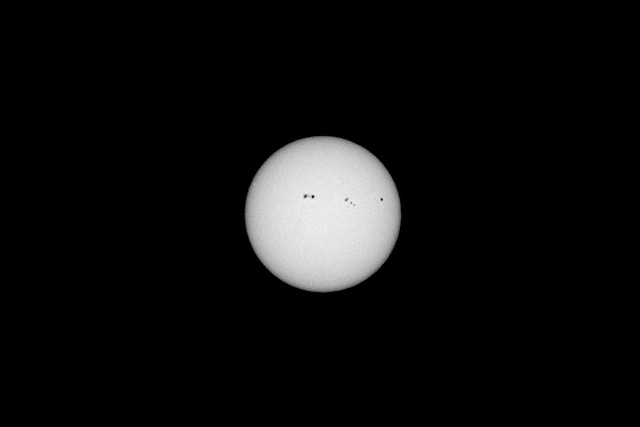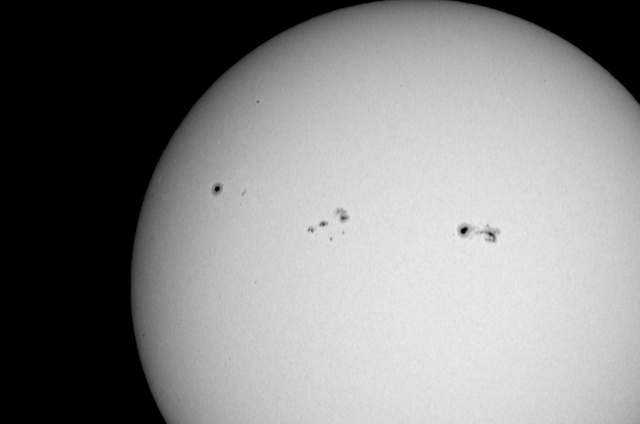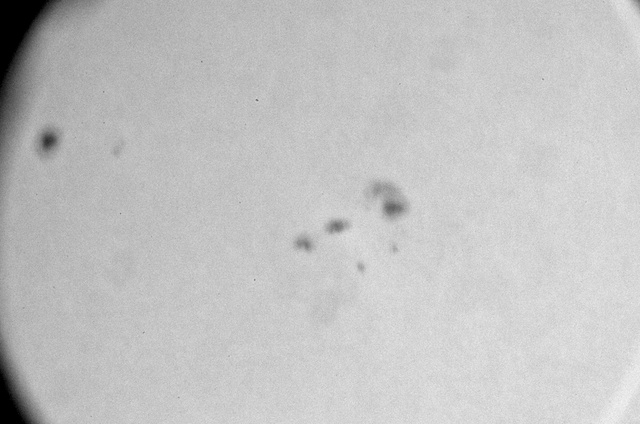
Finally, Some Observing: The Sun
Last updated: 2 August 2011![[Home!]](../../../../../etx/images/mighty_etx_logo_orig-sm.jpg)
 |
Finally, Some Observing: The SunLast updated: 2 August 2011 |
![[Home!]](../../../../../etx/images/mighty_etx_logo_orig-sm.jpg) |
| Follow @mweasner | Welcome | Photos | Videos | Equipment | Links | Data |
After my previous session on Thursday, 14 July, monsoon clouds and storms kept me from observing until Tuesday, 2 August. These past nearly three weeks have been the longest weather caused "no observing" period since "First Light" in the SkyShed POD on 18 August 2009. You can see some time-lapse videos on my webcam movies page. The nights with little or no moon would have been excellent as the nuisance light at the top of the hill to the east was OFF all but one of the nights of no observing! No light pollution was being created. Even though I wasn't observing, having the nuisance light off really improved the look of the surrounding area. No more ugly "bloody scar" along the top of the hill. I know the long-time local residents appreciate the light now being off. Thanks to the neighbors for realizing this and turning it off.
Thanks to Ryan Villegas (@RVDigital) who tweeted me the ID of the large bug I saw in the observatory on my previous observing session. It was a Solifugae Camel Spider. Another reference is at http://www.camelspider.org/. Impressive bug!
So, after all the cloudy days and nights, the sky was finally clear Tuesday morning, 2 August. I decided to take advantage of the break in the monsoon weather pattern and do some solar observing with the 8" LX200-ACF and the PST. I opened the observatory at 1030 MST, 102°F. I first captured the sun using the white light solar filter on my Nikon D7000. This image was taken at f/5.6, 1/1000sec, ISO 500, 300mm.

The (slightly cropped) image shows several sunspot groups on the solar disk. As with all the solar images from this session, I set the saturation to "0" during post-processing. I then did some observing with the 8" using the white light solar filter and the PST mounted piggyback on the 8" telescope The sunpots were very nice and many were large in the 26mm eyepiece on the 8". In the PST, with its Hydrogen-Alpha view, there were many small but nice prominences all around the solar limb. I added the focal reducer to the 8" telescope, which yielded a nice full disk view of the sun with the 26mm eyepiece. I captured this image (slightly cropped) at prime focus + focal reducer, 1/200sec, ISO 500:

I removed the focal reducer and captured this (uncropped) image, 1/200sec, ISO 1600, showing the sunspot groups:

I then attempted some images (uncropped) at prime focus + 3X TeleXtender, 1/160sec, ISO 3200:



These high magnification images suffer from the very high f/ ratio from the small aperture white light solar filter, which was designed for the ETX-90, not an 8" telescope. One of these days I have to get a better white light solar filter.
I then did some brief sunspot observing with the 8" at 231X. Nice views.
Closed the observatory at 1145 MST, 101°F.
In honor of the final landing of the Space Shutter Program on 21 July 2011, I tweeted this photo of the Pepsi soft drink can that I have kept since viewing the first Space Shuttle landing in person, 14 April 1981, at Edwards AFB, CA.

At the time, I was in the United States Air Force working on the Space Shuttle Program. I have many wonderful memories of those days, including receiving this US flag that was flown on STS-2.

Go to the previous report.
Return to the Cassiopeia Observatory Welcome Page.